

Having worked with hundreds of nonprofits over the years, I can tell you that organizations that develop and follow a well-thought-out nonprofit marketing plan grow faster and make a bigger impact than those that don’t. A holistic marketing strategy will help any size organization connect with prospects and strengthen current connections. Between investing in the right marketing tools and crafting your brand’s voice, there’s a lot that goes into making a name for yourself, though. Especially when you’re up against established organizations, it can be difficult to generate brand awareness for a smaller organization that’s just getting started. Whether you apply these steps to a single campaign or use them to inform your organization’s marketing strategy for the entire year, you can be sure they’ll help your team increase donations, grow membership numbers, deepen engagement and raise awareness. Be sure to download our Nonprofit Marketing Plan Template and fill it out as you go! Before diving straight into the steps you’ll need to follow, let’s explain exactly what a nonprofit marketing plan is.
A nonprofit marketing plan is a document that outlines the marketing activities needed to execute any type of campaign. It includes a detailed description of the types of marketing collateral that will need to be created and the key messages you want to communicate with each piece. This document should be made available to everyone in the organization, so they can refer to the main goals of the campaign and align their activities to it. Most nonprofits begin outlining their marketing plans and assigning roles with their Board (if Board involvement is needed) at the beginning of the new fiscal year. However, they can also be developed on a project-by-project basis throughout the year.

Once you have a clear sense of where you’ve gone right or wrong, you’ll be able to use that knowledge to inform your next strategy. For instance, maybe sending direct mail to your constituents hasn’t historically been effective. For your next marketing campaign, you might choose to focus more heavily on digital methods like social media or email marketing .
If you have enough time on your hands, you can conduct a more in-depth marketing audit beyond briefly looking at past campaigns. For instance, Getting Attention’s nonprofit marketing plan guide shares a step-by-step method you can use to analyze past performance.
You’ll want to collect past marketing collateral and campaign metrics, which you can then use to conduct a SWOT analysis. A SWOT analysis is a strategic planning technique used to identify your organization’s Strengths, Weaknesses, Opportunities and Threats (SWOT). In this case, you’ll be analyzing your marketing efforts in particular.
To conduct this type of analysis, draft a square that’s segmented into four quadrants, each devoted to a particular element of SWOT. Then, list different points under each heading that pertain to each. Here’s what each quadrant refers to:

Listing out these factors will give you a good visual representation of where your organization currently stands. From here, you can use this information to leverage your strengths to increase opportunities, reduce your threats, eliminate weaknesses and mitigate potential threats.
One small foundation I worked with was marketing their organization everywhere (Facebook, email, events, etc.) but getting little return for their efforts.
As I quickly discovered, the problem was that they were trying to accomplish multiple goals — increase donations , boost community engagement, raise awareness and more — all at once.
With such a small team, they were spreading themselves thin and bombarding their target audience with every type of ask.
From my experience, the nonprofit teams that focus on one primary goal at a time see the most success. As soon as I helped the foundation focus on one goal with their marketing campaigns (increasing donations), they started seeing better results.
If you need help deciding on a primary goal, here are several common nonprofit marketing goals I’ve seen organizations pursue:
Make sure your nonprofit marketing goal is tied directly to your organizational growth objectives. We all want to raise awareness of our organization and the work that we do, but what will this “raised awareness” get our organization at the end of the day? What do we hope to accomplish?
Small nonprofits typically see the best results when they prioritize one goal per quarter. Larger organizations with a marketing department of more than one person may be able to focus on two goals. It all depends on your staff’s bandwidth.
Since nonprofit organizational priorities constantly shift, consider reviewing your nonprofit marketing plan every quarter (three months). This doesn’t necessarily mean you need to craft a new one from scratch each time. Rather, you should examine and tweak your plan so that you can continue making sufficient progress.
A few years ago, a friend of mine decided to participate in a charity run. She showed up in a jogging outfit and dragged her way to the finish line. She came in dead last.
The following year, she signed up again, but this time, she was determined to come in first place. She began practicing four months before race day. She tracked her times, began eating better and even hired a trainer.
On the day of the race, she pushed herself harder than before and finished in the top 10% of all runners — something she never thought she could do.
The only thing that drove my friend to achieve such an amazing result was refining her objective: simply finishing the race vs. aspiring to come in first. By doing so, she was able to set incremental objectives along the way to ensure she was making sufficient progress.
In the same way, nonprofit professionals who refine their marketing plan objectives are able to accomplish their goals to a greater degree.
The best way I’ve seen nonprofits refine their objectives is by using something called the SMART objective framework . SMART stands for:

This framework has been adopted across many organizations and for good reason: it allows you to develop clear objectives that drive greater outcomes for your organization.
While the SMART framework can be applied to any strategic goals your nonprofit sets, let’s take a look at it in the context of marketing. For example, if your primary marketing goal is “raising awareness,” then some sample SMART objectives could be:
Once you’ve refined your SMART objectives, work with your team to set a schedule for activities that will help you achieve those goals.
All nonprofits are different and will have different SMART objectives to match their primary goals. To find the right numbers for your nonprofit, look at the existing marketing benchmarks or estimate to the best of your ability.
As this article has touched on, your goals should be tied to specific metrics. That way, you have a clear indication as to whether your efforts are paying off. Without tracking your nonprofit marketing plan’s performance, you won’t know where to invest your efforts next to improve results.
It’s important to note that different goals will be attached to different performance metrics. Salsa’s guide to nonprofit KPIs dives into several different metrics you might track and some of the ones specific to marketing include:
Tracking the right marketing analytics will take the guesswork out of those critical decisions, so you can maximize your ROI and focus on what’s yielding the best results. Not to mention, accurate KPI tracking also allows you to adapt your marketing strategies if you start to head in the wrong direction.
Of course, there are always other metrics and combinations of metrics that you might use — it all depends on your outreach methods. For instance, if you’re focusing on Google Ad Grants , you’ll look at conversions, click-through rates and website traffic to determine effectiveness. Text messages and direct mail may focus on response rates and cost per response.
There’s a lot going on in today’s fast-paced world. With so much on our minds, limited attention spans and the rise of information fatigue, nonprofits need to work harder than ever to cut through the noise and stay relevant to their audiences.
And what better way to beat the news cycle than by embracing it?
Before designing or launching your nonprofit marketing plan, ask yourself whether there are any current trends or news items you should incorporate into your strategy.
Known as “newsjacking,” this tactic can work wonders for strengthening brand awareness by leveraging common keyword searches and letting your audience know your cause is current and that you’re actively staying engaged in society.
Classic newsjacking is most effective on social media, where a growing number of people are turning for news and information. In fact, about half of U.S. adults say they get news from social media. However, you can also leverage news and trends through your blog, email marketing and website, especially with the growing dependence on digital news consumption.
Over the past couple of years, one of the most obvious news items has been COVID-19. With the pandemic impacting everyone’s lives, many people have watched how their favorite nonprofits responded. Another one that’s brought international attention is the Russian invasion of Ukraine.
Between new federal and local legislation, world conflicts and other widespread stories, there are plenty of news items that your nonprofit can leverage to increase its relevance. Find stories that are most relevant to your cause and use them to bolster your organization as an authority on the topic.
Of course, staying relevant is easier said than done. To give you some insight into how different nonprofit organizations accomplish this, let’s take a look at a few different examples.
Here’s an example of a Facebook post from SickKids Foundation . In it, they linked the newsworthy topic of the Winter Olympics to their mission to invest in children’s health:
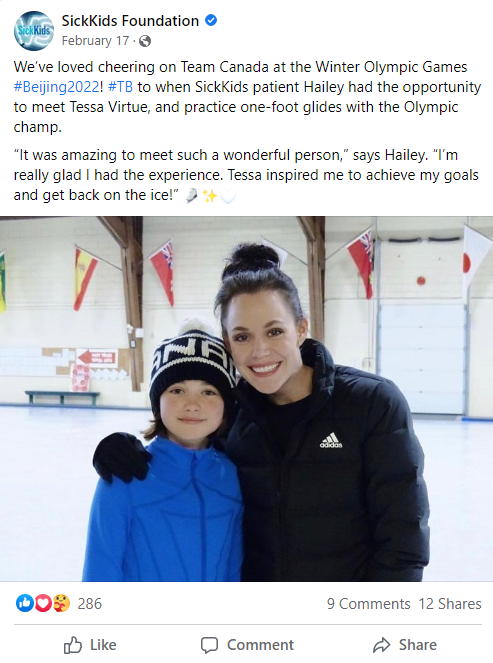
The World Food Program USA , an organization dedicated to fighting global hunger, also incorporates current events into its efforts. They developed a program specifically for providing critical food assistance to those affected by the war in Ukraine. Then, they used Google Ads to amplify the campaign’s landing pages:

Big Brothers Big Sisters of Canada has also been letting its followers know how the pandemic has been impacting the young people they serve and what community members can do to help:
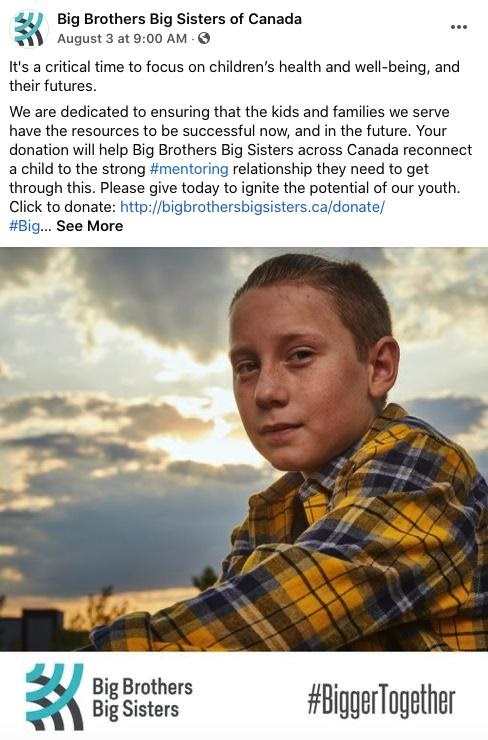
But staying relevant isn’t only about keeping up with the news. It’s also important to keep a close eye on holidays, awareness days and other observances. Consider which of these dates align with your mission – and then plan your marketing strategy accordingly.
Here’s an example from the Nature Conservancy of Canada , which promoted a conservation campaign for the Boreal Wildlands on Earth Day:

Takeaway: Before you start putting your marketing plan together, think about specific dates or news items you could leverage to stay relevant, capture your audience’s attention and deepen engagement with your cause.
Look at the number of likes on this Instagram post from Girls Who Code, an organization with a mission of closing the gender gap in tech, one girl at a time.

If you go to Girls Who Code’s Instagram Profile , you’ll find their posts have a considerable amount of likes and comments. While they certainly share powerful stories, their success is rooted in their understanding of their audience and their ability to connect with those individuals.
Girls Who Code was able to find and target a specific audience that responds to their mission. By marketing to that specific audience over time, they learned how to better connect with them — by sharing powerful stories of girls making a difference through their program.
They don’t worry about people who don’t understand or support what they do — they focus on their most passionate online community members and that leads to their success.
And that’s the key. Successful nonprofit marketing plans are targeted toward very specific audiences — and this is what the concept of personas is all about. Personas are fictional characters that help marketers envision someone who might respond to their marketing messages.
For instance, a few personas for Girls Who Code might be:
Once you’ve created your personas, you can start crafting a message that will connect with each one. Personas help humanize your marketing message since you can better imagine specific individuals you are speaking to rather than the entire world.
For instance, as you can see in the example screenshot, Girls Who Code’s marketing campaign was geared toward young women interested in coding. That’s why they included Coachella, social media filters and the American singer Doja Cat.
This is the hardest part of any nonprofit marketing campaign — getting your audience to pay attention long enough to take your desired action. This is also where most nonprofit marketers have the most fun, because creativity comes into play in a big way.
Think back to the goal you set for your marketing campaign. Based on that, what’s the core message you need to communicate to inspire your target audience to help you reach that goal? Tapping into effective storytelling practices and other strategies to share compelling messages will drive your campaign toward success.
Now, let’s take a look at a couple of real-world examples of what this looks like in practice. WaterAid wanted to get the word out to young people about their work to provide clean water and toilets to the world’s poorest communities. To do this, they took an approach many older donors might grimace at, but younger people embraced.
Back in 2015, they created a Poopmoji campaign , where supporters could create personalized poop emojis and share their creations with friends.

This campaign was wildly successful and resulted in a huge uptick in social shares, website traffic and email sign-ups. They understood their audience and what messages would inspire participation, resulting in a fun way to spread the word about a worthwhile cause.
But if you’re hard-pressed to come up with something as creative as WaterAid, don’t worry — you don’t need to be incredibly creative to craft an effective marketing campaign.
There’s another fail-proof way to create a compelling message that works for any nonprofit: the power of storytelling.
Donors and other philanthropists care about real stories. In fact, NPOInfo’s charitable giving statistics say that 42% of surveyed donors said that personal stories from a nonprofit’s beneficiaries influenced their decision to give.
Let’s take a look at an example of powerful storytelling from a small nonprofit. (As a bonus, this is also a great example of a SMART goal and multichannel marketing!)
Rosie’s Place , a women’s shelter in Boston, wanted to raise funds for its programs. They knew about SMART objectives, so they created an ambitious one: receive 500 gifts (of any size) in seven days from their online community (Facebook, Twitter and YouTube).
They also knew the power of storytelling, so they filmed a series of heart-warming (and often heart-wrenching) stories of women whom the shelter had helped. Every day during the campaign, they shared one of the videos with their online community along with their goal of 500 gifts in seven days. Here’s an example:

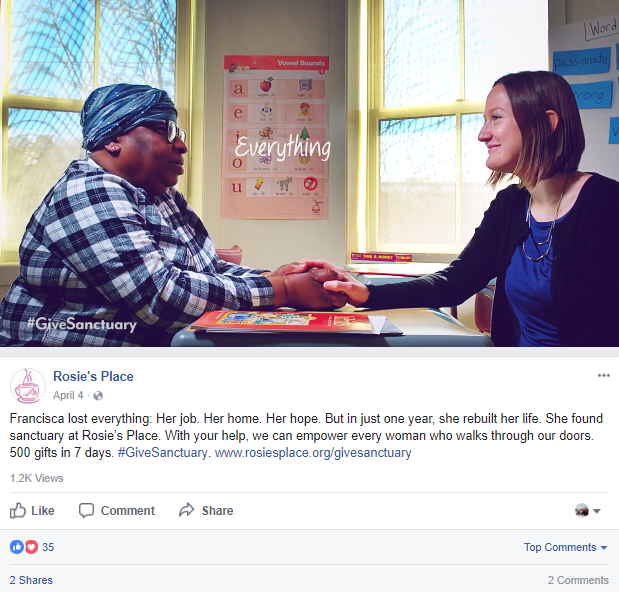
At the end of the week, they had received a total of 150 gifts — short of their 500 goal, but still incredible. Plus, they touched the hearts of hundreds of people online, compelling many to become regular donors to the shelter.
If you’re thinking of using storytelling to make your messages more powerful, take a similar approach to Rosie’s Place by searching for stories among the people your organization supports.
And once you’ve found a compelling story, the next step is to find the right platform to share it on.
Nonprofits tend to dive into leveraging several platforms headfirst — let’s post on Instagram, let’s start tweeting!
However, each marketing platform has different strengths and if you choose a blanket approach for every platform, your message may end up falling flat.
Instead, if you want to maximize your impact, it’s important to tailor your message based on each platform’s strengths. You need to determine which platforms your supporters prefer, then select a few to focus on. The only way you’ll curate a strong following is by not spreading yourself thin and not leveraging every single platform out there.
Let’s take a look at several different platforms you might use.
It’s no secret that social media is an important part of any nonprofit’s digital marketing strategies. With new platforms being created, it’s important to understand which ones you’ll actually want to create accounts for.
As you get started, here are four of the most popular ones that you’ll want to consider:
Depending on your cause and audience, you have plenty of options when it comes to social media. Be selective when picking the nonprofit marketing platforms that you’ll use to post about your work and push your cause forward.
According to 360MatchPro’s fundraising statistics , email has the highest ROI of any nonprofit marketing channel and 33% of donors say that email is the platform that most inspires them to give. In other words, email is a crucial marketing tool for your nonprofit.
Email is an intimate platform to speak with those who know you and trust you on a personal level. That’s why it’s ideal for:
Many nonprofits opt to send a regular newsletter, giving everyone on your email list a way to stay connected with your cause. They’re a fantastic way to share regular, quick updates on your mission and direct users to your website to learn more about all your great work.
Your website is your most important piece of digital marketing collateral, because it serves as the hub of all information related to your organization online.
It’s where many people will come across your cause for the first time, meaning it’s responsible for making a positive first impression on prospects. It’s also where people will go to find out more about your campaigns, donate to your cause and dig around to discover your organization’s mission and vision.
As such, building a well-designed website is a non-negotiable part of any modern nonprofit’s marketing strategy. However, it takes a bit more effort than you might initially think. Here are some key points to consider when creating your website’s layout:
As one of your main marketing platforms, a website is a crucial consideration for your marketing team. So spend time creating a website that users want to visit and explore.
Through its Ad Grants program, Google has launched a new wave of nonprofit marketing forward. Since its inception in 2003, it’s supplied organizations with more than $10 billion in free advertising money.
The Google Ad Grants program provides up to $10,000 a month in free advertising space for eligible nonprofits, enabling nonprofits of all sizes to tap into the power of online advertising to reach new and bigger audiences.
For instance, when you Google a term like “wildlife conservation volunteering,” you’re met with several results of wildlife rescue organizations promoting their volunteer opportunities.
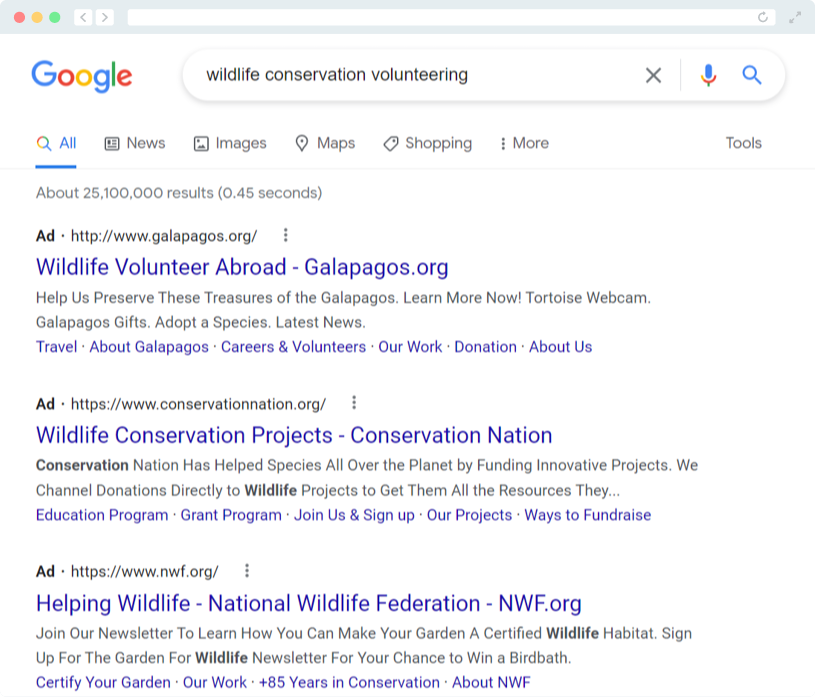
Think creatively about how you want to use your ad grant money. For instance, many nonprofits use their funds to promote:
Before jumping into this nonprofit marketing opportunity, think carefully about how Google Ads will play into your larger strategies. Do plenty of research into the program’s purpose and compliance regulations. Then, make sure your website is up to par with the program’s guidelines before applying.
If you’re curious about the program, dive into the program further with this Google Ad Grants basics guide on the Wild Apricot blog .
The David Suzuki Foundation provides a great example of how to execute a campaign across several platforms powerfully.
First, they made sure their homepage was set up to clearly showcase their campaign message:
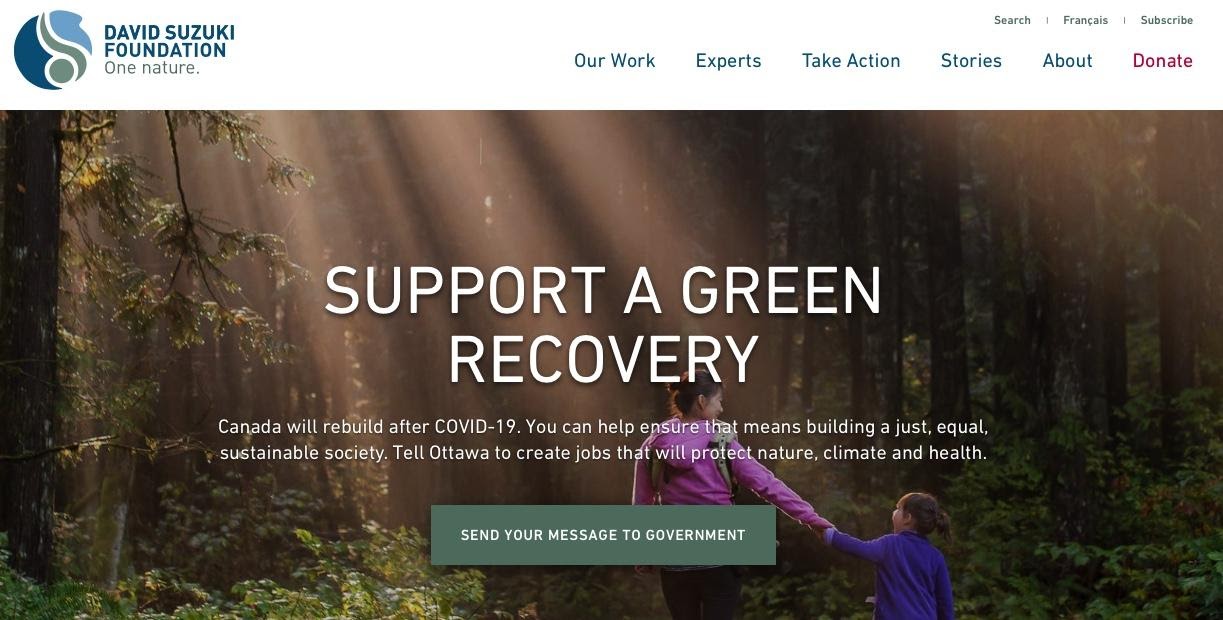
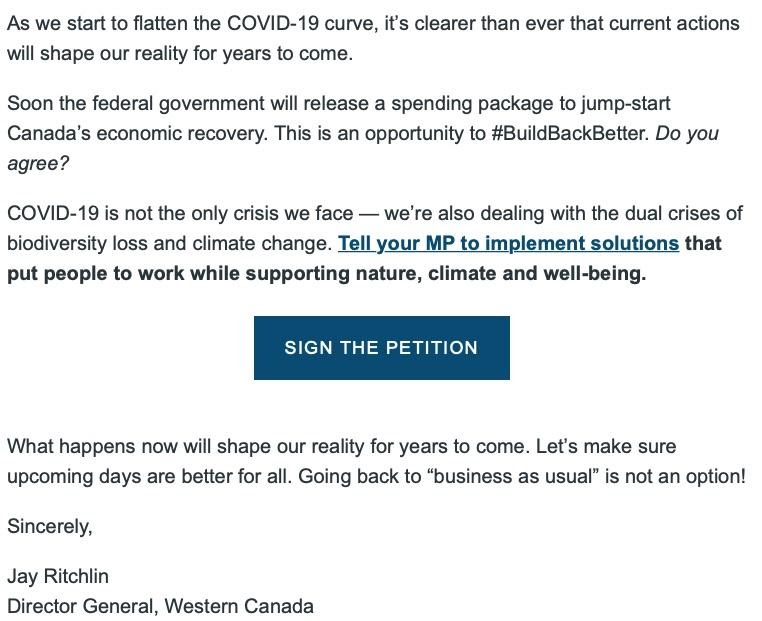
Then they sent out an email to their list, asking community members to get involved:
And finally, they backed up their message with compelling posts on their social media channels:
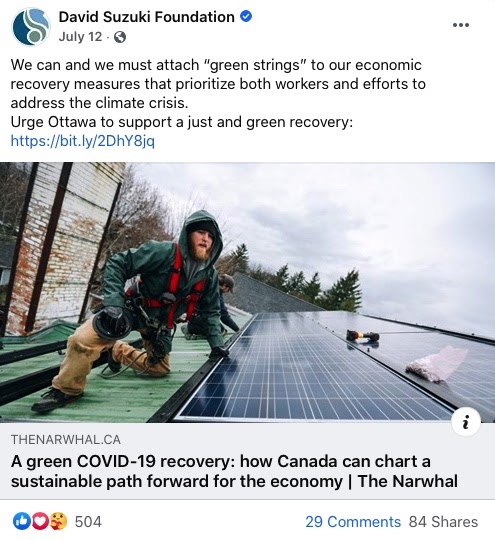
Implementing an integrated marketing campaign like this allows you to capture the attention of people across your network, rather than only promoting content to one platform’s audience.
The nonprofits that take the time to create a strategic, thoughtful and purposeful nonprofit marketing plan see the biggest impact when growing their organizations. Plus, there’s the added bonus of having a clear schedule upfront rather than posting online and emailing supporters sporadically.
If you’d like any help creating your marketing plan, feel free to get in touch with me . All the best with your nonprofit marketing plans!
And, if you want a PDF to help you put together your own nonprofit marketing plan, don’t forget to download our free template .